Review: Nokia 5700 XpressMusic Review
Score:
80%
The Nokia 5700 is a Symbian S60 3rd Edition FP1 smartphone. It's being sold under the XpressMusic sub-brand, which emphasises music and multimedia playback.
What is it like in real life?
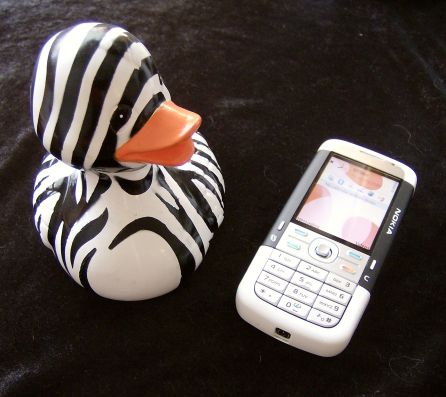 The 5700 is a monoblock phone which weighs 115 g. It has a casing made of glossy white plastic, and a black or red matt plastic middle section. There's a rubber flap on the right hand side which covers a microSD hotswap card slot, USB port and charging jack.
The 5700 is a monoblock phone which weighs 115 g. It has a casing made of glossy white plastic, and a black or red matt plastic middle section. There's a rubber flap on the right hand side which covers a microSD hotswap card slot, USB port and charging jack.The keypad is rather unusual, it can be twisted to four different positions, each allowing easier access to a specific function of the 5700:
- Keypad facing forward: this is the main mode of the 5700, which works just like keypads on any other phone.
- Playback controls facing forward: twisting the keypad round to this position automatically activates the music player.
- Camera facing away: this position automatically starts the camera application, and lets you photograph or video objects in front of you. If you're already using the phone's video player app, twisting to this position automatically changes the video to horizontal full screen mode, and it's physically possible to stand the 5700 on its side in this position so you can watch the video more easily.
- Camera facing forward: this position also automatically starts the camera app, and is intended for self-portraits and for videophone calls. This position also lets you stand the 5700 horizontally on its side so you can talk to the video camera without having to hold the phone.
The main keypad itself has clicky buttons with angled surfaces that let your finger distinguish one from the other. Above the keypad are the soft keys, call keys and S60 keys which generally work fine. However, the S60 menu key is somehow too closely connected to the left hand soft key, and occasionally you find yourself accidentally activating both. The 5700 has a joystick, and joysticks seem to divide opinion: some love them and some hate them. It's a matter of taste, but as joysticks go the 5700's is perfectly adequate, with a smooth metal finish that doesn't dig into your thumb the way the E61's joystick does. Personally I would have preferred a direction pad, but that's due to my own hatred of phone joysticks in general.
There are volume controls built into the left side, and the on/off button is on the top of the phone.
The playback controls are physically excellent, a vast improvement on the tiny buttons of the Nokia 3250. The 5700's controls take up as much space as possible, so they're as easy to press as possible.
The QVGA (240x320) 16 million colour screen is bright and crisp, with a sensor that turns the lighting on or off depending on how bright the surroundings are. You can set the sensor to various sensitivities, or switch it off, and you can also adjust the screen's auto switchoff time from 5 to 90 seconds.
Battery life is what you'd expect from a smartphone, and will vary wildly from one user to another depending on what they do and how much they do it. I used the 5700 as my main phone and found I had to recharge it every couple of days.
Overall the 5700 feels surprisingly solid, despite having a major moving part. The twisting keypad is very sturdily implemented, and doesn't feel loose at all. The phone isn't quite as chunky in real life as it might appear from the photos, it's much thinner than the 5300 for example. The curvy edges give it a nicer appearance than the 3250, and the multimedia controls are far superior.
As a phone
The 5700 is a Quadband (850/900/1800/1900) GSM and WCDMA/UMTS (2100) 3G phone, and as far as calls go it's up to the usual high Nokia standards. I never had trouble picking up a signal, I never dropped a call, and the sound quality was consistently good. The curvy edges made it comfortable to hold to my ear and the matt centre section stopped the phone slipping while being held.The 5700 has a speakerphone mode, and also supports all current bluetooth headset profiles including A2DP stereo. You can take calls (or redial the last dialed number) through A2DP-compatible bluetooth headphones with built-in microphones. Testing this feature with the Nokia BH-501 bluetooth headset, the callers I spoke to reported that I sounded just like I was using a phone normally.
If you have a 3G connection available, you can use the videophone mode, for which you have to twist the camera to face you and hold the 5700 horizontally. The twisted mode also lets you rest the phone horizontally on a table. You can also use the camera to record and send multimedia messages.
As a Music Player & Radio
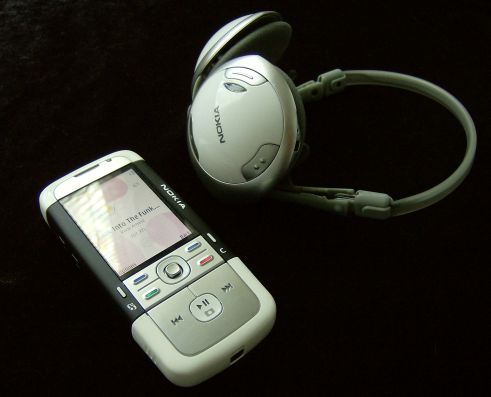 Accessing the 5700's music player is extremely intuitive: you just twist the playback controls round to face you, and the player application activates automatically. The controls themselves are very easy to use, with one large and two enormous buttons. To go back to the phone's standby screen, you just twist the normal keypad back to the front.
Accessing the 5700's music player is extremely intuitive: you just twist the playback controls round to face you, and the player application activates automatically. The controls themselves are very easy to use, with one large and two enormous buttons. To go back to the phone's standby screen, you just twist the normal keypad back to the front.
The music player is compatible with a wide range of audio standards (AAC, AAC+, eAAC+, MP3, MP4, M4A, WMA, Mobile XMF, SP-MIDI, AMR (NB-AMR), MIDI Tones (poly 64), RealAudio 7,8,10, True tones (WB-AMR), WAV) and you can transfer tracks using the Nokia Music Manager or Windows Media Player. The 5700 has a hotswap microSD memory card slot, which can use microSD cards with a capacity up to 2 gigabytes. Depending on what quality you like, this is enough space for roughly 500 to 1000 tracks using the AAC format or one of its variants. Tracks can be transferred through a standard USB cable, or via bluetooth, infrared or the internet.
The 5700 has an FM radio tuner, which like all phone FM tuners requires headphones or external speakers to be plugged in to act as the aerial. You can also download your local stations' frequencies via the internet from a worldwide database, and automatically use these as your presets. This saves a lot of bother at home, but it's also useful on journeys where you don't know the local stations. The 5700 also supports Visual Radio if you have access to it.
The 5700 has support for 2.5mm headphones that plug straight into the audio socket, 3.5mm headphones through an adapter, and stereo Bluetooth headphones. The sales package includes a 3.5mm adapter, which also has its own set of external music controls, and some 3.5mm headphones to plug into the adapter.
Sound quality is very good on the 5700, although it is largely determined by how good your headphones are. If you're an audiophile, I'd strongly recommend using your own favourite headphones. The included 3.5mm ones have good sound quality but seem to limit the volume, and using third party alternatives made the music much louder. You can use third party headphones through the 3.5mm adapter, or wirelessly through a BH-500 Bluetooth adapter.
The 5700's music player is silent between tracks (older S60 phones used to have a distinct crunching noise when tracks changed), and you can change tracks during playback without the music player panicking. It's worth emphasising that there IS a gap between tracks, even if it's silent, so if gapless playback is important to you (for example if a long classical piece is divided into several tracks) then you have to combine the piece's separate tracks into one big track on your PC, then transfer it to the phone. It's also worth mentioning that there's a one second delay between pressing a music control and the action actually taking place.
The 5700 has built-in stereo speakers, which are mounted along the left side of the phone in music mode but spread on the left and right sides of the phone in normal mode. The speakers are pretty loud (the phone shakes if you hold it at maximum volume) but as with all phone speakers they're a bit tinny and have trouble generating bass.
The 5700 is compatible with the A2DP Bluetooth profile, which lets you listen to music wirelessly through A2DP stereo Bluetooth headphones. It also supports the AVRCP Bluetooth profile which lets you change or pause tracks wirelessly. I tested the 5700 with Nokia BH-500 and BH-501 Bluetooth headphones, and was able to connect it to both. One thing that really threw me for a while is that you have to place both of these devices in a special mode during pairing, indicated by a blue/red light on the BH-501 and a rapidly-flashing blue light on the BH-500, otherwise they won't be found at all.
Once the pairing has happened, the headphones can be authorised to automatically connect to the 5700 without taking the phone out of your pocket or bag. The BH-500 and BH-501 both support this feature, although to activate the 501's automatic connection you have to press the 501's main button a second time after switching it on. Apologies to those who read my recent 501 review where I claimed it didn't support this feature... it does, but you have to read the manual carefully to find out.
If you haven't tried Bluetooth stereo headphones before, I'd strongly recommend giving them a go. As long as they're A2DP compatible they should work with the 5700, even if they're not made by Nokia. In the same spirit, Nokia A2DP headphones can be used with non-Nokia A2DP phones. A2DP is now becoming available even on lower-end phones such as the recently released 3110 Classic, and it seems likely that by 2008 almost all new Bluetooth-compatible phones will support A2DP.
What's puzzling about the 5700's music features is that there's no built-in 3.5mm headphone socket. This is by far the most common standard for headphones and audio cables, and although the 3.5mm adapter is perfectly good it's still another bit of kit that you have to remember to take with you. The 5700 isn't the thinnest phone on the market, and it seems likely that Nokia would have been able to fit a 3.5mm jack somewhere on the phone, but for some reason they haven't done it.
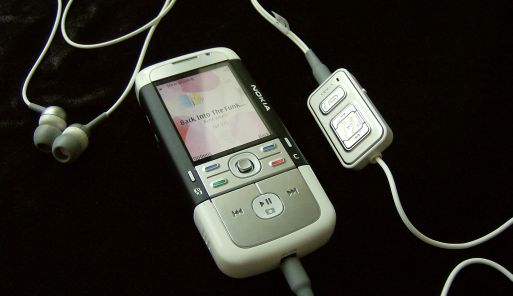
As a Video Player
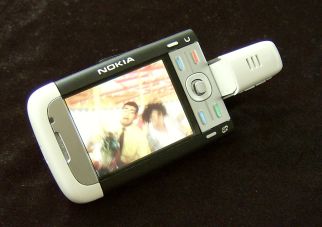 The built-in RealPlayer application handles video playback, or you can install third party alternatives such as SmartMovie. The 5700's twisting ability comes into play, as you can twist the keypad round so that the 5700 stands horizontally on a tabletop, which also automatically puts the video player into full-screen horizontal mode. You can twist back and forth between horizontal and handheld mode as much as you want, and the video continues to play. Video quality on the built-in player is excellent, and should provide stiff competition for third party playback apps.
The built-in RealPlayer application handles video playback, or you can install third party alternatives such as SmartMovie. The 5700's twisting ability comes into play, as you can twist the keypad round so that the 5700 stands horizontally on a tabletop, which also automatically puts the video player into full-screen horizontal mode. You can twist back and forth between horizontal and handheld mode as much as you want, and the video continues to play. Video quality on the built-in player is excellent, and should provide stiff competition for third party playback apps.
You can use the 5700's playback controls with videos in horizontal mode: Play/Pause plays and pauses, while Forward and Back take you forward or back within the current video. You have to hold Forward or Back down for a while to get them working.
The 5700 is officially supported by Nokia's new Video Manager PC application, which lets you convert existing video files on your PC into files suitable for playback on your phone. The first version of Video Manager was shockingly bug-ridden, however a new version has come out pretty quickly after the first one, and presumably Nokia will continue to issue regular updates as more and more compatible phones appear in the market.
As a Camera
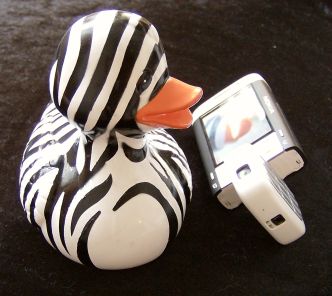 The 5700 has a 2 megapixel camera which can be activated by twisting the keypad so the camera faces away or towards you. The screen automatically goes into horizontal mode, and pictures are taken by pressing the white Camera/Play button in the centre of the playback controls. The Forward and Back controls zoom in and out using the digital zoom facility. The camera includes a flash.
The 5700 has a 2 megapixel camera which can be activated by twisting the keypad so the camera faces away or towards you. The screen automatically goes into horizontal mode, and pictures are taken by pressing the white Camera/Play button in the centre of the playback controls. The Forward and Back controls zoom in and out using the digital zoom facility. The camera includes a flash.
I found using the playback controls useful, partly because the large Camera/Play button was easy to activate, but mainly because in twisted mode it was easier to hold the phone steady with two hands. Alternatively, if you prefer taking pictures with one hand, the 5700's main body is light enough (and the keypad joint is sturdy enough) to let you hold the phone by the keypad alone.
Twisting the keypad back to its normal position deactivates the camera app automatically.
The camera can also shoot video at 320x240 pixels, the resolution of YouTube videos. The 5700's web browser is good enough to let you access the normal YouTube website and upload videos just as you would on a PC, and the 3G connection means you can upload large files fairly quickly. There's potential here for videos at concerts or sports events getting on YouTube within minutes of their being filmed.
The camera application has the following options: Image Mode, Video Mode, Panorama Mode (which helps you take two photos and join them together within the app), Night Mode (which can be activated for any other mode), Flash (always on, always off, automatic), White Balance (to take account of different lighting conditions), Colour Tone (which lets you film in normal colour, sepia, black and white or negative), Image Quality and Image Resolution.
Here are some sample photos so you can judge how good the camera is. The first three were taken on a cloudy day, the rest were taken on a sunny day: Sample 1 Sample 2 Sample 3 Sample 4 Sample 5 Sample 6 Sample 7 Sample 8
One bug pointed out by an AAS reader remained even after I had updated the firmware: if you try to move photos in the Gallery application from the images folder into a user-created sub-folder, the Gallery app only moves one photo at a time, even if you mark several to be moved at once. I also had problems moving photos out of sub-folders back into the main folder.
As a Computer
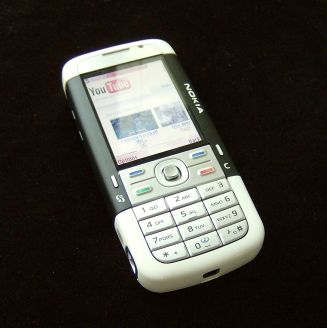 The 5700 is a S60 3rd Edition FP1 multi-tasking smartphone, and is compatible with S60 3rd Edition applications and games. You install apps just as you do on previous S60 3rd Editions, most easily by using the PC Suite's Application Installer program. You can also download and install apps straight onto your phone over the internet, for example through the built-in Download! application or through the phone's web browser.
The 5700 is a S60 3rd Edition FP1 multi-tasking smartphone, and is compatible with S60 3rd Edition applications and games. You install apps just as you do on previous S60 3rd Editions, most easily by using the PC Suite's Application Installer program. You can also download and install apps straight onto your phone over the internet, for example through the built-in Download! application or through the phone's web browser.
The 5700's browser is the now-standard Nokia S60 OSS browser, and you can download at broadband speeds thanks to the phone's 3G connection (although page rendering is slower than on a PC). The S60 browser is based on the same core as the Apple Safari browser, some sites will even mistakenly identify you as using Safari. You can visit most HTML and Flash-based sites, providing you remember to switch on the Flash support in Settings, although some processor-intensive features such as watching YouTube videos simply won't work (the rest of the YouTube site works fine). There are a couple of snags though: Some sites such as the BBC insist on auto-redirecting you to their cut-down mobile versions, and it would have been nice to be able to disguise your mobile origins. The other snag is that there's no option to work in horizontal mode (320x240) as well as vertical mode (240x320).
The 5700 runs the FP1 update of the S60 3rd Edition user interface, which contains new features and improvements over the ordinary 3rd Edition. You can read more about these in AAS's review of the 6290, but it includes sensible things such as putting all settings menus under one icon. I also found that the feature for indicating a still-running application, a blue circle next to its icon and folder, is actually very useful. At first I was sceptical but I've come to rely on the circles to remind me when an app has accidentally been left running, consuming battery life and precious RAM.
One rather worrying thing about the 5700 happened two or three times during the first week I had it: it inexplicably decided to reboot in the middle of using an application. I wasn't running any third party software, just the apps that came with the phone (for example the built-in City Bloxx game), and this is something that never ever happened to me with the almost-identical 6290. I updated the firmware of the 5700 and the reboots haven't happened since, so hopefully the problem has already been dealt with, but there were other occasional instabilities after the update. For example, while attempting to pair with a Bluetooth headset the phone crashed and I had to take the battery out to restart it. This kind of thing was relatively rare, but it shouldn't be happening at all, and didn't happen at all on the 6290.
The 5700 contains a 369MHz central processor, almost twice as fast as the processor found on something like the E61. It's difficult to compare the 5700 to phones like the N95 however, as the N95 contains two processors instead of one, so even though it has a lower clock speed than the 5700 it might actually be faster at getting tasks done.
Overall
Clearly the 5700 isn't going to win any fans from the "All phones must be thinner than an After Eight" brigade.
The 5700 is also not going to please the "Where's the wi-fi and DVD-quality camcorder?" market either, who will make woeful comparisons with the N95 and the like. However, the launch price of the 5700 is literally half the launch price of the N95, so it's hard to see how they can be compared directly.
The 5700 also isn't going to be bought by people who want phones to look very serious and business-like, but many of us don't want serious-looking phones. It's interesting to note that the 5700 is being promoted in China, where tastes and marketing are just a little bit different to the West.
The twisting keypad is much more than a novelty, it's genuinely intuitive, innovative and useful. Twisting the music controls to the front in effect turns the 5700 into a dedicated music player. Twisting the camera away from you lets you hold it more steadily to take better pictures. Twisting the camera towards you makes it a very convenient videophone or video diary camcorder, as it can be placed on a table and has exactly the right angle to film your face.
The unexplained reboots and occasional instabilities are worrying, although they were rare and some may have been eliminated by the latest firmware update. The lack of a direct 3.5mm headphone socket is a bit silly, especially when absolutely everything else is in place to make the 5700 a direct alternative to dedicated music players. The horizontal screen mode in the video player and camera app is very welcome, but it would have been nice to see this extended to the web browser as it has been on the N95.
Is the Nokia 5700 the phone for you? It's a matter of your technical requirements and taste. It doesn't have every smartphone feature, but its relatively low price tag reflects this. It does look quite quirky and isn't a thin phone, but some people prefer having something chunky, brightly coloured and with a unique character. To use a car analogy, the 5700 is perhaps the smartphone world's Mini Cooper.
Krisse, AllAboutSymbian, 2 June 2007
Buy the Nokia 5700 from the Nokia UK Shop
PS: You can see a video of the 5700 in action and some high resolution photographs on the 5700 page at the Nokia Duck Blog.
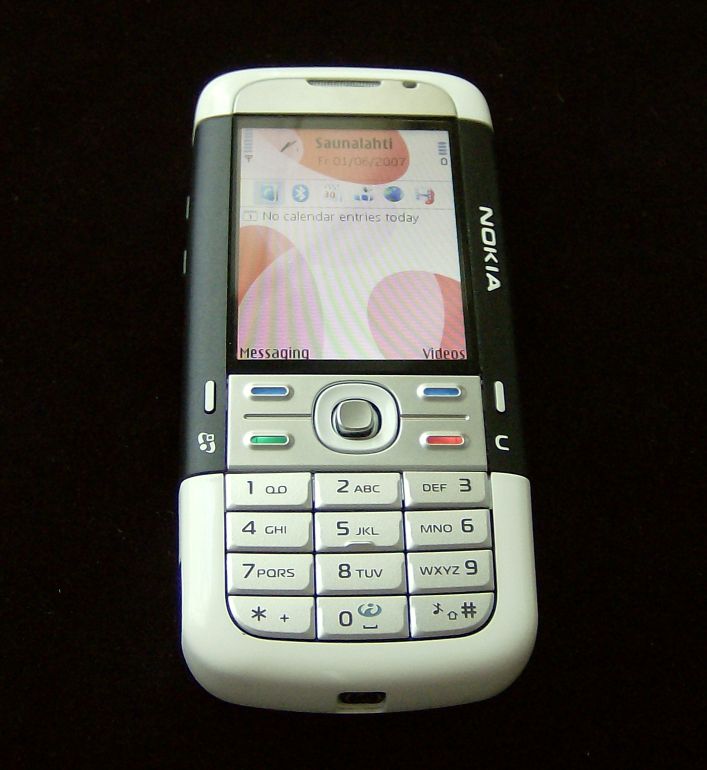
Reviewed by krisse at
